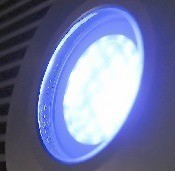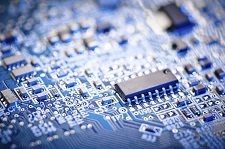
Semiconductors Defined
As the term might imply, semiconductors are materials with electrical conductivities between that of a conductor such as copper and an insulator such as glass, but their true value in electronic devices lies in the ability of their conductivity to be easily manipulated. Current conduction in a semiconductor occurs due to the movement of charge carriers: free electrons carry negative charge, while the spaces left behind when electrons move, often termed “holes”, carry positive charge. The inherent electrical properties of a semiconducting material can be manipulated by doping the material with impurities, which greatly increases the number of charge carriers available to conduct a current.
Semiconductor materials may be doped to be intrinsically n-type, having an excess of negative charge carriers, or p-type, having an excess of positive charge carriers. When doped semiconductors contact semiconductors of a different type, charge carriers become depleted in the region of this p-n junction. This depletion region is rectifying: it has the unique property of allowing current to flow only in one direction. This property is absolutely necessary to the operation of diodes and transistors. Additionally, the conductivity of a semiconductor can change on short timescales due to external conditions such as exposure to light or heat, the presence of an electrical or magnetic field, or mechanical deformation of its crystal structure. The effect of electrical fields on semiconductor conductivity is exploited in field-effect transistors, and sensitivity to other inputs allows the production of semiconductor-based sensors and photovoltaic devices.
Semiconductor Devices
The electronic circuit components which typically contain semiconductors are transistors and diodes. Diodes are two-terminal electronic components that act to control current within a circuit by only allowing current flow in a single direction, a property provided in semiconductor diodes by a single p-n or metal-semiconductor junction. Additionally, semiconductor diodes only begin conducting electricity if a certain threshold voltage is present, a property that can be tuned through the careful choice of semiconductor materials. These properties can be manipulated to produce a variety of special functions, including the production of light, as in light emitting diodes (LEDs) and laser diodes.
Transistors are three-terminal electronic components that can amplify or switch current within a circuit due to the ability of voltage applied at one of the terminals to alter the current through the remaining pair of terminals. The amplifying abilities of transistors are essential for sound reproduction, radio, transmission, and signal processing, while transistor switches are used in switched-mode power supplies and in logic gates.
While transistors can be made as individual circuit components, they are most often found on integrated circuits, and a single integrated circuit may contain several billion transistors. There are many types of transistors, but modern integrated circuits most often contain metal-oxide-semiconductor field-effect transistors (MOSFETs). Integrated circuits are produced by printing the various material layers of the component transistors and connecting circuitry on a substrate wafer. Photolithography processes are used to produce the extraordinarily small features necessary to pack many individual electronic elements in a small area. Integrated circuits are essential components of almost all electronic devices, and can be used to receive and process input from digital sensors, store and process information, and control electronic input/output devices or mechanical systems.
 The other major class of semiconductor devices is the solar cell, which converts energy from the sun into electricity via the photovoltaic effect, and is one of the major focuses within the field of green technology and alternative energy. For a more detailed discussion about the technology and advanced materials utilized in photvoltaic cells, visit the American Elements Photovoltaic & Solar Energy page.
The other major class of semiconductor devices is the solar cell, which converts energy from the sun into electricity via the photovoltaic effect, and is one of the major focuses within the field of green technology and alternative energy. For a more detailed discussion about the technology and advanced materials utilized in photvoltaic cells, visit the American Elements Photovoltaic & Solar Energy page.
Group IV Semiconductors
The group IV elements carbon, silicon, and germanium are all semiconductors in their pure form. The most widely used semiconductor material is crystalline silicon, notable for its useful functional temperature range as well as its abundance and consequent low raw-material cost, and found as the substrate for most integrated circuits as well as in the most widely used photovoltaics. Germanium was widely used in early semiconductor research, and in fact was the material used for the fabrication of the earliest integrated circuits, but its thermal sensitivity and lower abundance make it a less ideal primary material than silicon. Compounds of the group IV semiconductors are also useful semiconductors: silicon germanium (SiGe) is often used for very high-speed semiconductor devices, while silicon carbide is used in blue LEDs and is being investigated for use in semiconductor devices that can withstand extreme environmental conditions during operation. Typically semiconductors are used in crystalline forms, but amorphous silicon finds use in some thin-film solar cells.
Common Group IV Semiconductor Products
III-V
III-V semiconductors are binary compounds consisting of an element from group III and an element from group V. Gallium arsenide (GaAs) is the most commonly used semiconductor after silicon, and has some advantages over silicon for use in semiconductor devices: it exhibits higher electron mobility, allowing for the production of higher-frequency devices, and is less sensitive to heat and noise. Gallium arsenide is also superior for use in light-emitting and photovoltaic applications, as its direct bandgap allows it to both absorb and emit light more efficiently than indirect bandgap materials like silicon. Disadvantages of gallium arsenide include low hole mobility, more complex and costly fabrication, and its lack of a native insulating oxide analogous to silicon dioxide, all of which limit its usefulness for fabricating integrated circuits. GaAs is also often used as a substrate for the growth of other III-V semiconductors. The other III-V semiconductors are often found in optoelectronic devices such as infrared detectors and LEDs, or in various devices in conjunction with gallium arsenide.
Common III-V Semiconductors
II-VI
II-VI semiconductors are binary compounds consisting of an element from group II and an element from group VI. They typically have direct bandgaps and are found most frequently in solar cells, photoresistors, photodetectors, lasers and LEDs. Cadmium telluride (CdTe) solar cells are the most widely used thin-film solar cells. Additionally, aluminum-doped zinc oxide (ZnO:Al) is an important transparent conductive oxide used for conductive films in LCD displays and solar detectors.
Common II-VI Semiconductors:
Other binary semiconductors outside of these classifications exist, though the above classes are generally the most widely studied. The lead binary semiconductors, which are group IV-VI, could be considered an exception-lead sulfide has a long history of use in infrared detectors, and quantum dots of lead selenide and lead sulfide have recently received significant research interest. Additionally, copper sulfide was used along with cadmium sulfide in some of the earliest thin-film solar cells.
RELATED VIDEO
